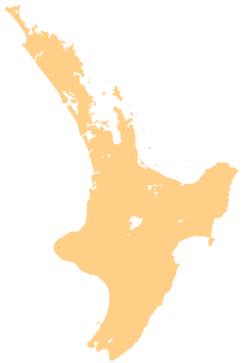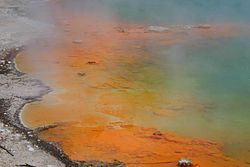Champagne Pool facts for kids
Quick facts for kids Champagne Pool |
|
|---|---|

The orange colour originates from deposits of arsenic and antimony sulfides.
|
|
| Location | Waiotapu, North Island |
| Coordinates | 38°21′33″S 176°22′08″E / 38.359086°S 176.368901°E |
| Type | geothermal |
| Basin countries | New Zealand |
| Max. length | 65 m (213 ft) |
| Max. depth | 62 m (203 ft) |
| Water volume | 50,000 m3 (1,800,000 cu ft) |
| Residence time | 34 days |
Champagne Pool is an amazing geothermal hot spring in the Waiotapu area of New Zealand's North Island. It's about 30 km (20 mi) southeast of Rotorua and 50 km (30 mi) northeast of Taupō. The pool gets its name because it bubbles a lot, just like a glass of champagne! This bubbling comes from lots of carbon dioxide (CO2) gas escaping.
This hot spring was created about 900 years ago by a big underground explosion of hot water and steam. In geology terms, that makes it quite young! The pool's opening is about 65 m (213 ft) wide. It's also very deep, reaching about 62 m (203 ft) down. It holds a huge amount of hot water, around 50,000 m3 (1,800,000 cu ft).
Contents
What Makes the Water Special?
The water deep below Champagne Pool is super hot, around 260 °C (500 °F)! But the water you see in the pool is cooler, staying between 73 °C (163 °F) and 75 °C (167 °F). This is because it loses heat to the air. The water's pH level is usually around 5.5. This means it's slightly acidic, and it stays steady because of all the CO2 gas.
Besides carbon dioxide, other gases like nitrogen (N2), methane (CH4), hydrogen (H2), and hydrogen sulfide (H2S) also come out of the pool. You can even find tiny traces of oxygen (O2).
Colorful Minerals in the Pool
The hot water in Champagne Pool carries many dissolved minerals. Some of these are metalloid compounds, like orpiment (As2S3) and stibnite (Sb2S3). When these minerals come to the surface, they settle and form bright orange layers under the water. These orange colours are a sharp contrast to the grey-white rock, called silica sinter, that surrounds the pool.
Tiny Life Forms in the Pool
Even though Champagne Pool is very hot and has unique chemicals, scientists have studied it to see if anything can live there. It turns out, some tiny living things, called microorganisms, can survive! They can use the hydrogen (H2) and either carbon dioxide (CO2) or oxygen (O2) in the water as energy to grow.
Scientists have found different shapes of these tiny cells in the hot spring, including long, round, and rod-shaped ones. They have even managed to grow two new types of bacteria and one new type of archaeon (another kind of tiny life form) from the pool.
Venenivibrio stagnispumantis
One special bacterium found here is called Venenivibrio stagnispumantis. This amazing microbe can handle high amounts of arsenic and antimony compounds, which are usually harmful. It's a completely new type of bacteria that scientists had never seen before! It belongs to a group called Aquificales.
Images for kids
See also
 In Spanish: Champagne Pool para niños
In Spanish: Champagne Pool para niños





